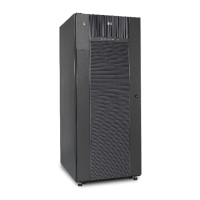Creating th e device files
If the device files were not created automatically when the system was restarted, use the
insf –e command in the /dev directory to create the device files. After this command is
executed, rep
eat the procedures in the p revious section Verifying device recognition to
verify new de
vice recognition and the d evice files and driver.
Example
# insf -e
insf: Install
ing special files for mux2 instance 0 address 8/0/0
::::
::::
#
Failure of the insf –e command indicates a SAN problem.
If the device files for the n ew disk array devices c annot be created automatically, you
must create
the d evice files manually using the mknod command as follows:
1. Retrieve th
e device information you recorded earlier.
2. Construct the device file na me for each device, using the device information, and
enter the file names in your table. Use the following formula to construct the device
file name:
cxtyd z
where x =S
CSI bus instance number y =SCSItargetIDz =LUN
c stands f
or controller, t stands for target ID, and d stands for device. The numbers
x, y, and z are hexadecimal.
3. Construct the minor number for each device, using the device information, and enter
the file names in your table. Use the following formula to construct the minor number:
0xxxyz0
0where
xx = SCSI bus instance number y =SCSItargetIDz =LUN
4. Display the driver information for the system using the lsd ev command.
Example
# lsd
ev
Character Block Driver Class
:::
:
188 31 sdisk disk
#
Disk Array XP operating system configuration guide: HP-UX
29

